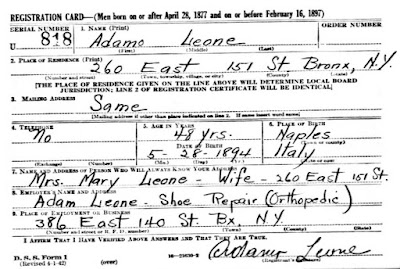I'm so lucky. All of my ancestors who emigrated sailed from Naples to New York between 1890 and 1920. The only document collection I need is "New York Passenger Lists". And every one of my people went through Ellis Island.
 |
| Ellis Island, December 2017 |
The ship manifest—the list of passengers on a particular ship for a particular journey—can tell you your ancestor's hometown. That alone is a significant boon to your genealogy research. It can lead you to their foreign vital records.
I'm more excited to find an ancestor who arrived in the U.S. in 1909 or later because there is likely to be a two-page manifest listing extra information.
The most treasured two-page ship manifests can provide your ancestor's:
Manifest Page 1
 |
| Not a nuclear family, but 4 out of 5 of these men are mine! |
- Ship name (you can look for a photo of the ship)
- Departure date and port city
- Last name—a maiden name for many women

- Given name
- Age
- Gender
- Marital status
- Occupation
- Ability to read and write
- Nationality
- Race or people (e.g., Italian)
- Last residence (country and town)

- Name and location of nearest relative left behind

- Destination state and town
Manifest Page 2
 |
| And they were all going to the same place! |
- Arrival date and port city
- Whether they have a ticket to their final destination
- Who paid for their passage
- How much money they are carrying
- If and when/where they were in the U.S. before

- Person they are joining here, often including the name and address of a relative

- Place of birth (country and town)

- A bunch of sure-fire extreme vetting questions, including (these are reworded):
- Are-you-a-deadbeat type questions, such as were you in prison, an almshouse, or supported by charity?
- Are you a polygamist?
- Are you an anarchist?
- Are you coming here because of a job offer?
- Condition of mental and physical health
- Are you deformed or crippled?
- Height, complexion, hair and eye color
- Identifying marks (including scars)
These are the blanks to be filled in for each person, but there is another set of facts for a genealogist to crave. Family members!
Sometimes you'll find an entire family traveling together. Or you may see a mother and her children, and the manifest will show the name and address of her husband who is already in the United States. Jackpot!
Your ancestor's ship manifest—assuming they did not sail so early that no questions were asked—should be the first thing you search for. You can't go back overseas and get that birth certificate if you don't know your ancestral hometown.
Not sure where to start? Check the census for your ancestor. It may include their immigration year.








